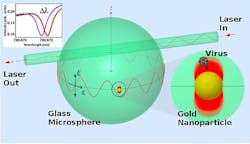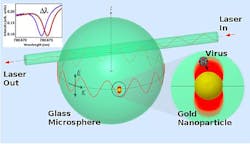Biosensor able to detect smallest virus opens door for earlier disease detection
Researchers at the Polytechnic Institute of New York University (NYU-Poly) have developed an ultra-sensitive biosensor capable of identifying the smallest single virus particles in solution, which could advance early disease detection at the point-of-care and cut waiting for test results from weeks to minutes.
Stephen Arnold, university professor of applied physics and member of the Othmer-Jacobs Department of Chemical and Biomolecular Engineering, and researchers of NYU-Poly's MicroParticle PhotoPhysics Laboratory for BioPhotonics (MP3L), completed a series of experiments to devise a low-cost diagnostic method sensitive enough to detect and size a single virus particle in a doctorâs office or field clinic, without the need for special assay preparations or conditions.
Most recently, the researchers were able to detect the smallest RNA virus particle MS2, with a mass of only 6 attograms (ag), by amplifying the sensitivity of a biosensor. Within it, light from a tunable laser is guided down a fiber-optic cable, where its intensity is measured by a detector on the far end. A small glass sphere is brought into contact with the fiber, diverting the light's path and causing it to orbit within the sphere. This change is recorded as a resonant dip in the transmission through the fiber. When a viral particle makes contact with the sphere, it changes the sphereâs properties, resulting in a detectable shift in resonance frequency.
The smaller the particle, the harder it is to record these changes. Viruses such as influenza are fairly large and have been successfully detected with similar sensors in the past. But many viruses such as polio are far smaller, as are antibody proteins, and these require increased sensitivity.
Arnold and his co-researchers achieved this by attaching gold nano-receptors to the resonant microsphere. These receptors are plasmonic, and thus enhance the electric field nearby, making even small disturbances easier to detect. Each gold âhot spotâ is treated with specific molecules to which proteins or viruses are attracted and bind.
In experiments, the researchers successfully detected the smallest RNA virus in solution, and they are now training their sights on detecting single proteins, which would represent a major step toward early disease detection.
âWhen the body encounters a foreign agent, it responds by producing massive quantities of antibody proteins, which outnumber the virus. If we can identify and detect these single proteins, we can diagnose the presence of a virus far earlier, speeding treatment,â explains Arnold. âThis also opens up a new realm of possibilities in proteomics,â he says. âAll cancers generate markers, and if we have a test that can detect a single marker at the protein level, it doesnât get more sensitive than that.â
The patent-pending technology, co authored with postdoctoral fellow Siyka Shopova and graduate student Raaj Rajmangal, is ultimately designed for a point-of-care device capable of detecting viruses or disease markers in blood, saliva, or urine. Testing for commercial applications is already underway.
What's more, the biosensor itself, called a Whispering Gallery-Mode Biosensor, is unique to Arnoldâs work. Its name derives from the famous Whispering Gallery in the dome of St. Paulâs Cathedral in London. Much the way its unique acoustics allow a whisper to be heard anywhere within the circular gallery, light traveling within the glass sphere of the biosensor orbits many times, ensuring nothing on the surface is missed.
The work has been published in Applied Physics Letters; for more information, please visit http://apl.aip.org/resource/1/applab/v101/i4/p043704_s1?bypassSSO=1.
-----
Follow us on Twitter, 'like' us on Facebook, and join our group on LinkedIn
Laser Focus World has gone mobile: Get all of the mobile-friendly options here.
Subscribe now to BioOptics World magazine; it's free!

